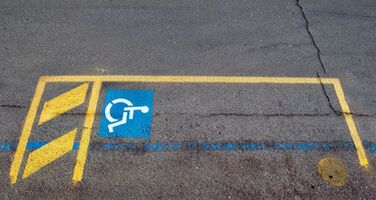
Explore Some of the Legal Requirements for a Handicap Parking Space?
What Are the Legal Requirements for a Handicap Parking Space?
Disabled spaces are designated for people with disabilities or mobility issues. But to park in these spaces, one has to acquire an accessible parking plate or placard. Americans with Disability Act (ADA) has set legal minimum standards that all disabled parking spaces must meet. You will find those federal guidelines well explained here. The details entail everything a disabled person needs to know to move around easily.
What Are The Legal Requirements For A Handicap Parking Space? According to ADA and state laws, all private businesses and public agencies should have a minimum number of parking spaces for the disabled. Also, the spaces should have a minimum size and be easy to spot. Proper signage makes the parking space visible.

You cannot use a handicap parking space unless you have a DP permit, plate, or placard issued by your home state. ADA updated its guidelines in 2010. The number of disabled spaces required by each parking lot after 2010 differs slightly from those built before.
How Many Disabled Parking Spots Are Required In a Parking Lot?
ADA sets parking lot standards. The agency requires each parking lot to reserve some spots for the disabled. The minimum number of disabled parking spots a parking lot should have depends on its size as follows;
• A parking lot with 1 – 25 spaces should designate one spot for handicapped parking
• A parking lot with 26 – 50 spaces should have two parking spots for people with disabilities
• A parking lot with 51 – 75 spaces should have three handicap parking spots
It means that for every 25 parking spots, there should be one spot for the disabled. For example, a parking spot with 150 spaces should have six spaces reserved for the disabled. Some parking lots are large, with over 500 parking spaces. In a parking lot with 500 spots, there should be nine spots for the disabled and another two for vans.
If a parking lot has over 1,000 spots, 20 must be accessible to the disabled. Also, you must find each of these disabled spots in every 100 spots. And there must be a minimum of one parking lot accessible to a van for every six parking spots reserved for the handicapped.
The case is different for the medical facilities. They should reserve 20% of their total space for the disabled. Within the space, they should build handicap parking spots accessible to the facility's entrance. The spaces should meet all the disabled requirements by ADA.
What Makes A Legal Handicap Parking Space?
A legal DP space entails some details. The location of a disabled parking spot matters. You cannot place it anywhere. It must be located where it's accessible to the route leading to the building. Also, it must be near the building entrance to make the travel distance short. The disabled person should not strain to move from his vehicle to the building's door.
Also, you cannot construct a parking slot for the disabled of any size. According to ADA, DP spots should contain a specific size. The width should be at least 8ft, and each should contain an adjacent aisle space. Every adjacent space should have a width of at least 5ft. The parking space for a disabled person's van should be a minimum of 11ft wide. Like the other disabled parking spot, it must be accessible to a path leading to the building's entrance from the aisle. The distance between the parking and the building entrance should be short.
Does There Have To Be A Sign For Handicap Parking?
The answer is yes. ADA has set sign requirements for handicapped parking spaces. First, they must be designated properly with the International Symbol of Access. It's also known as the International Wheelchair Symbol. It signifies that the parking is accessible to a disabled person. This symbol entails a blue background and a person in a wheelchair painted in white.
But in certain cases, the symbol is not applicable. ADA exempts parking lots with four or fewer parking spots from having this symbol embedded on the disabled spot. Also, private parking lots are not required to have the International Symbol of Access since you're the only one using the spot.
How High Does A Handicap Sign have To Be?
You cannot place any length size of a handicap sign. ADA has guidelines on the height each should have from the ground. It shouldn't be below 5ft from the ground. All signs should go above 5ft off the ground. If the sign indicates that the spot is accessible to a van, it should denote it. All-access aisles should be marked using diagonal lines.
Handicap Parking Spot Penalties
The Department of Justice enforces ADA standards and requirements. Therefore, you should adhere to the disabled parking standard, rules, and regulations set by ADA. Otherwise, charges can be placed against you, your business, or other people who do not comply. If you keep on violating the rules, you can be charged up to $150,000. A parking lot may have spots for the disabled to park but maybe less or doesn't meet ADA's requirements. Some states charge misdemeanor crimes against owners of such parking lots. Before constructing a parking space for the disabled, know the standards required and comply. Otherwise, you'll find yourself in trouble with the law.
As a disabled person, you will find problems when you park in a handicapped spot without a handicap parking placard or plate. Ensure you have a proper handicap permit. Please keep track of its expiry dates to renew it in time. Expired disabled permits are not allowed. If caught, you may be fined or issued a civil infraction in the form of a parking ticket. Also, the authorities can tow your car away depending on where you've parked it.
How Many Disabled Parking Spots Are Required In A Parking Lot?
The number of disabled parking spots required in a parking lot depends on the size and capacity of the parking lot. However, there are specific guidelines that determine the minimum number of disabled parking spots required based on the total number of parking spaces in the lot.
In the United States, the Americans with Disabilities Act (ADA) provides guidelines for accessible parking spaces. According to these guidelines, accessible parking spaces must be provided in each parking area based on the total number of parking spaces in the lot. The following table shows the minimum number of accessible parking spaces required:
| Total Number of Parking Spaces in Lot | Minimum Number of Accessible Parking Spaces |
|---|---|
| 1-25 | 1 |
| 26-50 | 2 |
| 51-75 | 3 |
| 76-100 | 4 |
| 101-150 | 5 |
| 151-200 | 6 |
| 201-300 | 7 |
| 301-400 | 8 |
| 401-500 | 9 |
| 501-1000 | 2% of total parking spaces |
| 1001 and over | 20, plus 1 for every 100 over 1000 |
It's important to note that accessible parking spaces must be located on the shortest accessible route to an accessible entrance, and they must be marked with the international symbol of accessibility. The spaces must also be at least 96 inches wide, with an adjacent access aisle that is at least 60 inches wide. Additionally, the access aisle must be marked with diagonal stripes to indicate that it is not a parking space.
What color paint for handicap parking?
In the United States, the Americans with Disabilities Act (ADA) provides guidelines for accessible parking spaces, including the color of paint that should be used for handicap parking spaces. According to the ADA guidelines, the parking space and access aisle for handicap parking should be marked with a bright blue color, known as "International Symbol of Access Blue."
This color is a standard shade of blue that is easily recognizable and provides good contrast against the pavement to help people with disabilities identify the accessible parking spaces. The blue color should be used for both the handicap parking space and the access aisle adjacent to it, which should also be marked with diagonal stripes to indicate that it is not a parking space.
It's important to follow the ADA guidelines for marking accessible parking spaces to ensure that people with disabilities have equal access to parking facilities and can safely and easily navigate them.
Legal handicapped requirements entail a lot. You should know everything to comply and enjoy easy disabled parking. Fortunately, the requirements are not rocket science. You can easily remember them. What Are the Legal Requirements for a Handicap Parking Space has been answered!
.png)





